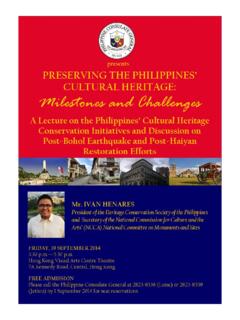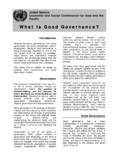Transcription of 2016 Global Report on Trafficking in Persons1
1 2016 Global Report ON TRAFFICKINGIN PERSONSUNITED NATIONSNew York, 2016 Global Report onTrafficking in Persons2016 united nations office ON DRUGS AND crime ViennaThis publication may be reproduced in whole or in part and in any form for educational or non-profit purposes without special permission from the copyright holder, provided acknowledgement of the source is citation: unodc , Global Report on Trafficking in Persons 2016( united nations publication, Sales No. ).Comments on the Report are welcome and can be sent to: crime Research SectionResearch and Trend Analysis BranchDivision for Policy Analysis and Public AffairsUnited nations office on Drugs and Box 5001400 ViennaAustriaE-mail: (+43) 1 26060 0 Fax: (+43) 1 26060 75223 The content of this publication does not necessarily reflect the views or poli-cies of unodc , Member States or contributory organizations, and nor does it imply any document has not been formally edited.
2 The designations employed and the presentation of material in this publication do not imply the expres-sion of any opinion whatsoever on the part of the Secretariat of the UnitedNations concerning the legal status of any country, territory, city or area, orof its authorities, or concerning the delimitation of its frontiers or boundaries. united nations , December 2016. All rights reserved, UNODCUNITED nations PUBLICATIONS ales No. : 978-92-1-130339-1e-ISBN: 978-92-1-058408-11 PREFACE Since the last Global Report on Trafficking in Persons in 2014 there have been a number of significant develop-ments that reinforce this Report s importance, and place it at the heart of international efforts undertaken to combat human Trafficking . Perhaps the most worrying develop-ment is that the movement of refugees and migrants, the largest seen since World War II, has arguably intensified since 2014.
3 As this crisis has unfolded, and climbed up the Global agenda, there has been a corresponding recog-nition that, within these massive migratory movements, are vulnerable children, women and men who can be easily exploited by smugglers and traffickers. Other changes are more positive. In September 2015, the world adopted the 2030 Sustainable Development Agenda and embraced goals and targets on Trafficking in persons. These goals call for an end to Trafficking and violence against children; as well as the need for measures against human Trafficking , and they strive for the elimination of all forms of violence against and exploitation of women and girls. Thanks to the 2030 Agenda, we now have an underpinning for the action needed under the provisions of the UN Convention against Transnational Organized crime , and its protocols on Trafficking in persons and migrant smuggling.
4 Another important development is the UN Summit for Refugees and Migrants, which produced the groundbreak-ing New York Declaration. Of the nineteen commitments adopted by countries in the Declaration, three are dedi-cated to concrete action against the crimes of human traf-ficking and migrant smuggling. unodc s Report is also the last before the world gathers in 2017 at the UN Gen-eral Assembly for the essential evaluation of the Global Plan of Action to Combat Trafficking in Persons. These decisive steps forward are helping to unite the world and produce much needed international cooperation against Trafficking in persons. But, to have tangible success against the criminals, to sever the money supplies, to entertain joint operations and mutual legal assistance, we must first understand the tex-ture and the shape of this Global challenge. The Global Report on Trafficking in Persons does exactly this.
5 It pro-vides a detailed picture of the situation through solid anal-ysis and research. The findings are disturbing. Traffickers may target anyone who can be exploited in their own countries or abroad. When foreigners are traf-ficked, we know that human Trafficking flows broadly follow the migratory patterns. We know from the Report that some migrants are more vulnerable than others, such as those from countries with a high level of organized crime or from countries affected by conflicts. Just as tragi-cally, 79 per cent of all detected Trafficking victims are women and children. From 2012-2014, more than 500 different Trafficking flows were detected and countries in Western and Southern Europe detected victims of 137 different citizenships. These figures recount a worrying story of human Trafficking occurring almost everywhere. In terms of the different types of Trafficking , sexual exploi-tation and forced labour are the most prominent.
6 But the Report shows that Trafficking can have numerous other forms including: victims compelled to act as beggars, forced into sham marriages, benefit fraud, pornography production, organ removal, among others. In response, many countries have criminalized most forms of traffick-ing as set out in the UN Trafficking in Persons Protocol. The number of countries doing this has increased from 33 in 2003 to 158 in 2016. Such an exponential increase is welcomed and it has helped to assist the victims and to prosecute the traffickers. Unfortunately, the average number of convictions remains low. unodc s findings show that there is a close cor-relation between the length of time the Trafficking law has been on the statute books and the conviction rate. This is a sign that it takes time, as well as resources, and exper-tise to chase down the criminals. Perhaps the 2016 Report s main message is that inroads have been made into this horrendous crime .
7 We must, however, continue to generate much needed cooperation and collaboration at the international level, and the necessary law enforce-ment skills at the national and regional levels to detect, investigate and successfully prosecute cases of Trafficking in persons. The 2016 Report has done a fine job of setting out the situation, but there is more to be done. Yury FedotovExecutive DirectorUnited nations office on Drugs and CrimeAcknowledgementsThe 2016 Global Report on Trafficking in Persons was prepared by the unodc crime Research Section under the supervision of Jean-Luc Lemahieu, Director of the Division for Policy Analysis and Public Affairs and Angela Me, Chief of the Research and Trend Analysis Branch. Core teamKristiina Kangaspunta, Fabrizio Sarrica, Tejal Jesrani, Raggie Johansen,Cecilia design, layout and mapping supportSuzanne Kunnen, Kristina crime Research Section wishes to thank the unodc Human Trafficking and Migrant Smuggling Section for their careful reviews and constructive comments on draft content, and the Section s interns, Tomas Horehaj, Julia Litzkow and Gamze Subasi, who have all made solid contributions to the 2016 Global Report .
8 Moreover, valuable inputs were received from many focal points for Trafficking in persons/organized crime at various unodc Field Offices; inputs that have clearly enriched the Report , and for that, we are Report also benefited from the work and expertise of many other unodc staff members in Vienna and around the wishes to thank the artist Yasser Rezahi who generously donated the artwork used for this Report . Photos of artwork by Johannes contain pictograms from Executive summary 5 Introduction 13 CHAPTER I - Global OVERVIEW PATTERNS OF Trafficking IN PERSONS 23 Trafficking FLOWS 39 THE LEGISLATIVE AND CRIMINAL JUSTICE RESPONSE TO Trafficking IN PERSONS 47 CHAPTER II HUMAN Trafficking , MIGRATION AND CONFLICT 57 CHAPTER III WESTERN AND CENTRAL EUROPE 71 EASTERN EUROPE AND CENTRAL ASIA 84 NORTH AND CENTRAL AMERICA AND THE CARIBBEAN 89 SOUTH AMERICA 97 EAST ASIA AND THE PACIFIC 102 SOUTH ASIA 109 SUB-SAHARAN AFRICA 112 NORTH AFRICA AND THE MIDDLE EAST 118 TEXT BOXES The Sustainable Development Goals and Trafficking in persons 30 Trafficking in persons for marriage 32 The use of detected cases of Trafficking in persons to draw patterns and flows 39 Multiple Systems Estimate.
9 An innovative way to help assess the real extent of Trafficking in persons 47 Trafficking of migrants for extortion and organ removal on some African routes 62 Trafficking for forced labour in the fishing industry 1045 EXECUTIVE SUMMARY Number of citizenships among victims detected in destination countries, by region of destination, 2012-2014 Source: unodc elaboration of national data. 1) NO COUNTRY IS IMMUNE FROM Trafficking IN PERSONSV ictims are trafficked along a multitude of Trafficking flows; within countries, between neighbouring countries or even across different continents. More than 500 differ-ent Trafficking flows were detected between 2012 and 2014. Countries in Western and Southern Europe detected vic-tims of 137 different citizenships. Affluent areas such as Western and Southern Europe, North America and the Middle East - detect victims from a large number of coun-tries around the victims from countries in Sub-Saharan Africa and East Asia are trafficked to a wide range of destina-tions.
10 A total of 69 countries reported to have detected victims from Sub-Saharan Africa between 2012 and 2014. Victims from Sub-Saharan Africa were mainly detected in Africa, the Middle East and Western and Southern Europe. There are also records of Trafficking flows from Africa to South-East Asia and the 20406080100120140160 Western and Southern Europe16 countriesNorth America3 countriesNorth Africa and the Middle East10 countriesSub-Saharan Africa10 countriesCentral and South-Eastern Europe13 countriesEast Asia and the Pacific8 countriesSouth America8 countriesCentral America and the Caribbean7 countriesEastern Europe and Central Asia8 countriesSouth Asia7 countriesNumber of citizenships detected Diffusion of Trafficking flows: numberof countries where citizens ofcountries in the given subregionswere detected, 2012-2014 Source: unodc elaboration of national data.












